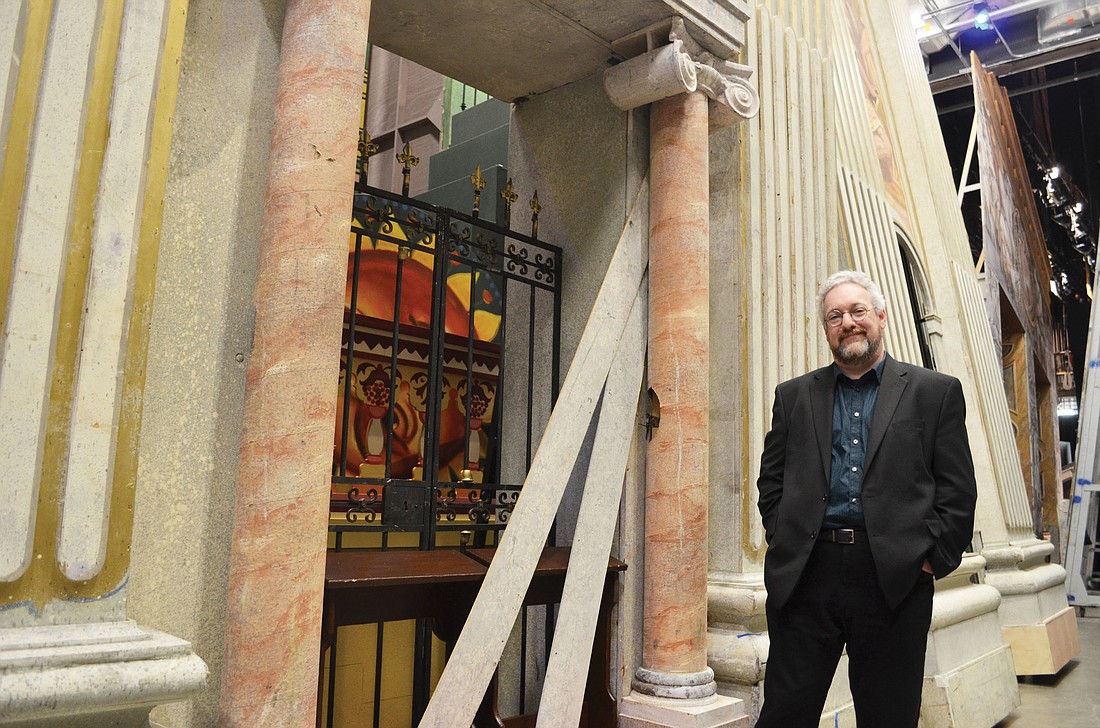- November 24, 2024
-
-
Loading

Loading

When David P. Gordon was 3 years old, his grandfather, a violinist in the Philadelphia Orchestra, thrust a child-sized violin into his tiny hands. Gordon came from a long line of classical musicians — his father was a cellist in the Philadelphia Orchestra and his great uncle was a violinist in the Budapest String Quartet.
It was assumed Gordon would follow in their classical-playing footsteps.
But, a couple of months later, Gordon’s grandfather quietly confiscated the violin. Gordon didn’t have the chops to be a string player.
So, instead of the violin, he turned to crayons, pencils and pens for his creative outlet. And with opera and classical music constantly playing around the house, it wasn’t a leap for him to combine his love of drawing and his family’s deep roots in musical performance into his future career.
“When I was about 10 or 11 years old, my parents took me to my first opera, ‘Tosca,’” says Gordon. “I had heard a lot of them at home, and my mother told me the stories as we listened to them on Saturday afternoons. After I got home from my first opera, I came home and made a model set out of shirt cardboard and lit it with flashlights. I decided then and there that that was what I wanted to do.”
Working as a professional set designer for the last 30 years, Gordon has spent every season with the Sarasota Opera since 1995. Three out of the four productions in the opera’s winter repertory star Gordon’s scenic creations. The colorful, bombastic and diverse worlds of “Tosca,” “The Golden Cockerel” and “Don Carlos (Paris version)” first came to life inside Gordon’s mind.
“I think that people think set design is just decoration or background,” says Gordon. “For me, it really is a crucial environment where the piece takes place and should become part of a whole world that the audience buys into.”
Before the curtain rises, before the sets are built, and before Gordon creates rough sketches, he studies his shows. As a faculty member at Rutgers University’s Mason Gross School of the Arts, Gordon emphasizes the intrinsic value of learning with each new production.
“I love the research,” says Gordon. “Everything you do takes place in a different world, and while you research you learn all kinds of things. It’s a great general education.”
For this winter season at Sarasota Opera, Gordon dived into the architectural and production history of each piece as well as the most valuable asset: the music.
“In an opera you have the music to work with and that helps really describe the world that’s onstage,” says Gordon. “I feel you really have to know the material inside-out. It’s your most important piece of research.”
In “Tosca,” Gordon re-created the opera’s real-life Roman settings, such as the church of Sant’Andrea della Valle, the opulent mansion Palazzo Farnese and the imposing fortress of the Castel Sant’Angelo.
“The Golden Cockerel” is a Russion opera that deals with the inner-political workings of a despondent king in a near fairytale world. Gordon created a design pastiche that incorporates the work and design of 20th-century Russian illustrator Ivan Bilibin and the French illustrator Edmund Dulac, who had both done illustrations depicting Alexander Pushkin’s original story on which the opera is based.
And this year’s production of “Don Carlos” is the original uncut Paris version that has all five acts instead of four. The challenge for Gordon is that acts two through five are all set throughout Spain and share a common architectural style. But for the often-omitted first act, the opera opens in the dead of winter in the forest of Fontainebleau, France.
However, no matter the difficulty of the season, it’s worth all the research and attention to detail for Gordon to create the desired effect: complete audience immersion.
“If all the elements are correct, then the audience is going to buy into the world, and that’s the important part,” says Gordon. “When it all comes together, it transports you to a whole different place, and that’s what I’ve always loved about it.”
Scenic start
In high school, David P. Gordon’s art teacher connected him with Tony Award-nominated set designer Clarke Dunham. Gordon apprenticed with Dunham in his studio in Philadelphia as well as his offices in New York City.
“I would visit his house on Saturday mornings and show him what I was doing, and he’d give me advice and guidance,” Gordon said.
This mentorship continued when Gordon attended New York University’s prestigious Tisch School for the Arts. The young professional designer worked as an assistant in Dunham’s studio, which allowed him to make the connections to begin his own independent design career. In 1985, the year he graduated from Tisch, Gordon took his United Scenic Artist union exam and received his first independent opportunity to design. The Center for Contemporary Opera was searching for a designer for an upcoming production of Robert Kurka’s “The Good Soldier of Schweik,” and the organization asked Dunham if he could recommend someone. His apt pupil was more than ready to accept the challenge.
This first job was in Martin Luther King Jr. High School’s auditorium on Amsterdam Avenue, which was adjacent to the opera world beacon: the Metropolitan Opera.
Fun fact
David P. Gordon’s grandfather kept his violin collection in the bathtub.
IF YOU GO
Where: Sarasota Opera House, 61 N. Pineapple Ave.
Tickets: $29 to $135
Info: Call 366-8450
“Tosca” by Giacomo Puccini
Feb. 7 to March 28
“The Marriage of Figaro” by W. A. Mozart
Feb. 14 to March 27
“The Golden Cockerel” by Nikolai Rimsky-Korsakov
Feb. 21 to March 19
“Don Carlos (Paris version)” by Giuseppe Verdi
March 7 to 24